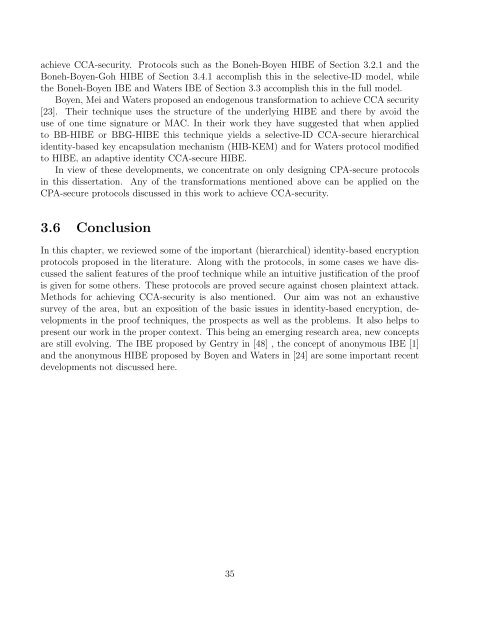Identity-Based Encryption Protocols Using Bilinear Pairing
Identity-Based Encryption Protocols Using Bilinear Pairing
Identity-Based Encryption Protocols Using Bilinear Pairing
Create successful ePaper yourself
Turn your PDF publications into a flip-book with our unique Google optimized e-Paper software.
achieve CCA-security. <strong>Protocols</strong> such as the Boneh-Boyen HIBE of Section 3.2.1 and the<br />
Boneh-Boyen-Goh HIBE of Section 3.4.1 accomplish this in the selective-ID model, while<br />
the Boneh-Boyen IBE and Waters IBE of Section 3.3 accomplish this in the full model.<br />
Boyen, Mei and Waters proposed an endogenous transformation to achieve CCA security<br />
[23]. Their technique uses the structure of the underlying HIBE and there by avoid the<br />
use of one time signature or MAC. In their work they have suggested that when applied<br />
to BB-HIBE or BBG-HIBE this technique yields a selective-ID CCA-secure hierarchical<br />
identity-based key encapsulation mechanism (HIB-KEM) and for Waters protocol modified<br />
to HIBE, an adaptive identity CCA-secure HIBE.<br />
In view of these developments, we concentrate on only designing CPA-secure protocols<br />
in this dissertation. Any of the transformations mentioned above can be applied on the<br />
CPA-secure protocols discussed in this work to achieve CCA-security.<br />
3.6 Conclusion<br />
In this chapter, we reviewed some of the important (hierarchical) identity-based encryption<br />
protocols proposed in the literature. Along with the protocols, in some cases we have discussed<br />
the salient features of the proof technique while an intuitive justification of the proof<br />
is given for some others. These protocols are proved secure against chosen plaintext attack.<br />
Methods for achieving CCA-security is also mentioned. Our aim was not an exhaustive<br />
survey of the area, but an exposition of the basic issues in identity-based encryption, developments<br />
in the proof techniques, the prospects as well as the problems. It also helps to<br />
present our work in the proper context. This being an emerging research area, new concepts<br />
are still evolving. The IBE proposed by Gentry in [48] , the concept of anonymous IBE [1]<br />
and the anonymous HIBE proposed by Boyen and Waters in [24] are some important recent<br />
developments not discussed here.<br />
35
















